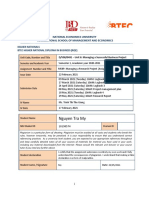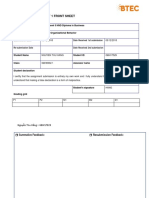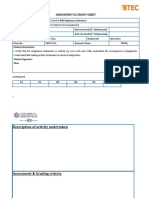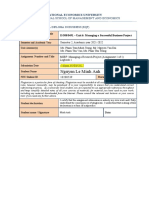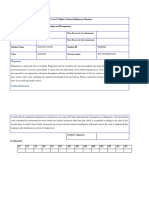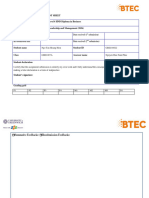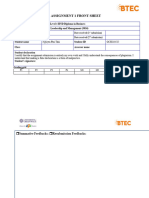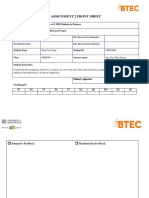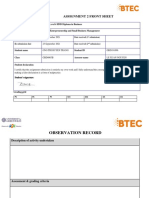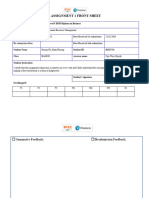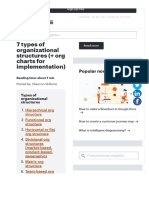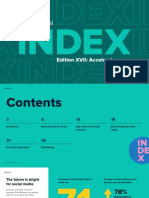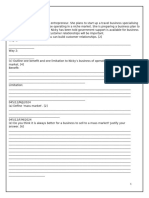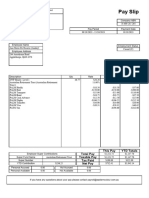Asm 1 - 5036
Asm 1 - 5036
Uploaded by
phuongdi1245Copyright:
Available Formats
Asm 1 - 5036
Asm 1 - 5036
Uploaded by
phuongdi1245Original Title
Copyright
Available Formats
Share this document
Did you find this document useful?
Is this content inappropriate?
Copyright:
Available Formats
Asm 1 - 5036
Asm 1 - 5036
Uploaded by
phuongdi1245Copyright:
Available Formats
lOMoARcPSD|30907450
1008 ASM1 5036 ko cần chỉnh
Introduce Management (Trường Đại học FPT)
Scan to open on Studocu
Studocu is not sponsored or endorsed by any college or university
Downloaded by Hoang Thi Minh Phuon (FPI HN) (phuonghtmbh00706@fpt.edu.vn)
lOMoARcPSD|30907450
ASSIGNMENT 1 FRONT SHEET
Qualification BTEC Level 4 HND Diploma in Business
Unit number and title Unit 4: Leadership and Management (5036)
Submission date 03/04/2022 Date received (1st submission)
Re-submission date Date received (2nd submission)
Student name ĐỖ THỊ QUÝ Student ID GBH200759
Class GBH1008 Assessor name NGUYỄN THỊ NGÂN
Student declaration
I certify that the assignment submission is entirely my own work and I fully understand the consequences of plagiarism. I
understand that making a false declaration is a form of malpractice.
Student’s signature:
Grading grid
P1 P2 P3 P4 M1 M2 M3 D1
Downloaded by Hoang Thi Minh Phuon (FPI HN) (phuonghtmbh00706@fpt.edu.vn)
lOMoARcPSD|30907450
Summative Feedbacks: Resubmission Feedbacks:
Grade: Assessor Signature: Date:
Internal Verifier’s Comments:
Signature & Date:
Downloaded by Hoang Thi Minh Phuon (FPI HN) (phuonghtmbh00706@fpt.edu.vn)
lOMoARcPSD|30907450
Contents
I: Introduction ................................................................................................................. 4
1: Management concept ................................................................................................. 4
1.1: Define management ................................................................................................ 4
1.1.2: Discuss manager skills ...................................................................................... 4
1.2: Leadership concept.................................................................................................. 5
1.2.1: Define leadership ........................................................................................... 5
1.2.2: Discuss leader skills ....................................................................................... 5
1.3: Difference between management and leadership from key skill ......................... 6
2: Discuss mmanagement and leadership theories ......................................................... 7
2.1: Five management theories ................................................................................... 7
2.1.2: Three important management theories .......................................................... 7
2.2: Approaches to leadership ................................................................................... 10
2.2.1: 3 important approaches ................................................................................ 11
3: Leadership and management styles.......................................................................... 13
4: Types of organizational culture ................................................................................ 15
II: Conclusion ............................................................................................................... 17
References: ................................................................................................................... 17
Downloaded by Hoang Thi Minh Phuon (FPI HN) (phuonghtmbh00706@fpt.edu.vn)
lOMoARcPSD|30907450
I: Introduction
Currently, there are many businesses appearing, withstanding the market's competitiveness, standing
firm and constantly developing. The core of most businesses is people-centered. Therefore,
management and leadership play an important role for the success of the business. MB Bank is an
outstanding enterprise in that. MB Bank is Military Commercial Joint Stock Bank, has 26 years of
establishment and development. MB has affirmed its position as one of the top banks in Vietnam
(Annual report, 2020). MB will be a model to learn, learn to serve the job. In this report, theories,
skills and approaches of management and leadership will be clearly presented, focusing on
comparing differences, critically evaluating to improve knowledge and experience.
1: Management concept
1.1: Define management
Management is the work of administration, aimed at aligning the needs of employees with
the requirements and goals of the organization. Management applies available resources, performs
activities that set strategies, guide, and coordinates employees to accomplish the overall goals of the
organization (Mullins, 2019).
1.1.2: Discuss manager skills
A good manager needs a lot of elements and skills. There are 5 skills mentioned including
Technical skills, interpersonal skills, conceptual skills, diagnostic and political skills. Technical
skills refer to the ability to comprehend and use specialized information, methods, and strategies to
complete jobs (Mullins, 2019). Interpersonal skills are those that are concerned with interpersonal
relationships. Managers will utilize this ability to collaborate successfully as members of a team
(Mullins, 2019). Managers must have excellent communication skills as well as the ability to work
successfully with people from various cultures. In implementing management style, this talent
stresses coordination, cooperation, and adaptability (Mullins, 2019). To see the complexity of an
organization, you'll require conceptual skills. It is the ability to take a holistic view of a situation
and devise a strategic plan to act and achieve a goal. This ability aids managers in generalizing
problems and making sound judgments (Mullins, 2019). Diagnostic skill is the ability to investigate
and make judgments about how to solve issues (Mullins, 2019). The capacity of a manager to build
Downloaded by Hoang Thi Minh Phuon (FPI HN) (phuonghtmbh00706@fpt.edu.vn)
lOMoARcPSD|30907450
connections among employees in order to achieve the organization's common goals is referred to as
political skill (Mullins, 2019).
Assumption: MB bank is one of the most used banks. In the two years 2020 and 2021, MB attracts
1.86 million users (Annual Report, 2020). Therefore, in March 2022, MB had an impressive media
campaign and invested a lot of money to continue to break through. The manager held a meeting
with 6 employees, announced the campaign and clearly stated the requirements of the work done in
5 such as main colors, fonts, slogans, logos,... In 5 days , the manager regularly works with
employees, solves problems right when needed, keeps track of employees. In addition, the
management always backs up multiple copies to avoid machine failure and unexpected file loss. As
a result, the banners and posters designed by them are very suitable, the manager and the staff have
succeeded in this task.
The above situation clearly demonstrates the three skills of a manager: conceptual, technical, and
interpersonal communication. First, managers have conceptual skills demonstrated by the fact that
the leadership has reviewed the overall task, devised a plan for employees to perform, including
application time and job requirements. . Second, technical skills are demonstrated through a
manager's understanding of the job's content, goals, requirements, and details of employee
communication. Managers clearly understand the processes and methods of specific activities.
Finally, interpersonal skills are demonstrated by the manager working with the employee as a team
member, discussing and coordinating to achieve the best results.
1.2: Leadership concept
1.2.1: Define leadership
Leadership is the ability to inspire, positively influence people, and support people to
achieve the common goals of the organization (Durbin, 2012).
1.2.2: Discuss leader skills
Leaders have 7 basic skills needed, including communication, motivation, delegating, positivity,
trustworthiness, creativity, and problem-solving. Communication is a talent that allows leaders to
convey and explain the organization's objectives, operations, and goals to employees in a clear and
simple manner (Durbin, 2012). Employees, as well as everyone else in the organization, are
motivated by a leader's motivation. Employee motivation is a significant factor in their ability to
Downloaded by Hoang Thi Minh Phuon (FPI HN) (phuonghtmbh00706@fpt.edu.vn)
lOMoARcPSD|30907450
perform well at work (Durbin, 2012). Delegating is a talent in which a leader clearly recognizes
each employee's strengths and assigns responsibilities based on their abilities (Durbin, 2012).
Positivity contributes to a pleasant and healthy work atmosphere. People will be less stressed, and
the leadership-employee connection will improve (Durbin, 2012). The degree of leadership
trustworthiness is called trustworthiness. Employees will trust and appreciate a boss who has
gained reputation (Durbin, 2012). Creativity demonstrates a leader's ability to think logically and
make distinctive and innovative judgments (Durbin, 2012). The capacity to take a team through a
challenge and solve it in a logical manner is known as problem-solving. Furthermore, leaders must
be able to absorb and listen to comments from others (Durbin, 2012).
Assumption: Fashion house Yody is scheduled to hold a spring collection launch show. Leaders
have clearly discussed and shared about the purpose, content and mission of the performance with
employees. The company invited models to show off their outfits. Right at the time of the event,
staff and management received news that the main model was positive for Covid 19 and could not
continue to participate in the event. Leaders reassure and motivate people. The leader responds by
choosing one person on the team to replace that person. The reasonable handling of the situation
helped the event to take place successfully.
The above situation has demonstrated 3 skills of a leader including communication skills, problem
solving skills and positive skills. Firstly, communication skills are demonstrated by conveying
information clearly to employees so that employees can understand it properly. Problem-solving
skills are demonstrated through pre-event modeling incidents. Leaders actively motivate people,
avoid creating a stressful atmosphere, and have assertive problem solving methods that make the
event a success.
1.3: Difference between management and leadership from key skill
Management is more formal and scientific than leadership. Management skills are used by managers
to manage resources to provide products or services. Managers' power comes from their position.
Leadership skills are needed to interact, motivate, and persuade people to follow the same vision and
goals. Leaders gain power through their thoughts and behaviors (Durbin, 2012).
Downloaded by Hoang Thi Minh Phuon (FPI HN) (phuonghtmbh00706@fpt.edu.vn)
lOMoARcPSD|30907450
2: Discuss mmanagement and leadership theories
2.1: Five management theories
In this report, five approaches to organizational theory and structure are mentioned. The classical
approach emphasizes planning, hierarchy, control requirements, clearly defining logical principles
in the organization towards a common goal (Mullins, 2019). The human relations approach
identifies ways in which employee productivity and motivation can be increased, through
performance recognition, employee recognition, and positive relationships within the organization.
(Mullins, 2019). Quantitative approaches to decision making are supported by quantitative
techniques (Mullins, 2019). The systems approach is a management approach that treats an
organization as a unified system, consisting of related and purposeful parts. Management
coordinates different parts of the organization and understands the impact of external factors on the
organization. Contingency approach towards an extension method. There is no single best way to
manage and operate in a situation where the same outcome cannot be achieved. From there,
managers need to find a harmony between tasks, people and the environment to achieve common
goals (Mullins, 2019).
2.1.2: Three important management theories
*Classical approach:
This is an approach that promotes rationality and makes organizers and employees most productive.
The classical approach is considered from three angles: administrative theory, scientific
management, bureaucracy (Mullins, 2019). First, about scientific management, Taylor believes that
there is a best method by which everyone should do their job (Mullins, 2019). The scientific method
is aimed at increasing the productivity of each employee, leading to high efficiency in the
organization. Workflows can be broken down into tasks and the scientific method is applied to
figure out the best way to do the task. For this method, managers need to recruit, train and help
employees do the job. Workers need to absorb and properly implement new methods (Mullins,
2019). Administrative management is a method based on the use of principles to manage an
organization. 14 principles were introduced by Fayol along with the common development in
management principles (Mullins, 2019). Firstly, the principle of division of work is based on the
assignment of tasks to each employee. Next is the principle of authority and responsibility,
Downloaded by Hoang Thi Minh Phuon (FPI HN) (phuonghtmbh00706@fpt.edu.vn)
lOMoARcPSD|30907450
discipline of employees. Working in any organization requires discipline, responsibility, and
entitlement. The organization should follow unity of command and unity of direction. Followed by
principles including the dependence of self-interest, remuneration, degree of concentration, scalar
series. These are principles that help organizations and employees work together to achieve a
common goal. In addition, there is order, fairness, stability in terms of personnel tenure, initiative,
esprit de Corps. The equality and creativity of workers should be respected and guaranteed.
Bureaucratic management is done in such a way that the organization is divided into departments
with specific tasks. This is the work done by managers and officers in charge to ensure the
performance of the organization (Mullins, 2019).
Example of MB bank: Analysis from the organizational structure of MB Bank. MB Bank is
divided into departments, each of which is responsible for different tasks. MB Bank includes
departments such as finance and accounting, human resources, marketing ... (Annual report, 2020).
According to the 2020 annual report, the Human Resources Committee is responsible for advising
the Board of Directors on the size and structure, proposing the appointment planning, and the
company's development strategy. When the organization assigns work to each department, each
department, and each employee, the efficiency will increase. Work will also be carried out in a
systematic manner. Moreover, this also shows the appropriate choice of the organization to recruit
employees who match the requirements and nature of the job. Besides, when the organization is too
rigid with the classical approach, the human aspect can be forgotten. In addition, creativity and
differences among people are also not developed. To overcome and achieve good results, the
organization needs to harmonize many approaches, not to be overly imposed.
Downloaded by Hoang Thi Minh Phuon (FPI HN) (phuonghtmbh00706@fpt.edu.vn)
lOMoARcPSD|30907450
Partial diagram of MB Bank's organizational structure (Annual report, 2020)
*Human relations approach:
As society develops, people pay more attention to the working environment and employee behavior.
The essence of this method is to focus on the relationship between people. Through positive
relationships, employee productivity and motivation are likely to increase. When employees are
empowered with self-determination, equal participation, performing to their full potential, and being
treated positively, productivity increases (Mullins, 2019).
For example: Masan is a testament to motivating employees to work more effectively, making
employees feel proud. Masan Joint Stock Company has issued nearly 5.8 million shares to reward
25 employees in recognition of their contributions. In the first months of 2019, Masan reported a
profit of nearly VND 1,000 billion, the company's profit was VND 865 billion (Nguyen, 2019). This
is Masan's effective way of doing it. It helps employees become shareholders of the company, feel
proud of themselves and their achievements are recognized. The advantage is shown in the
employee's increased work motivation and increased work productivity. However, the organization
also needs to pay attention to objective environmental factors, and non-financial rewards to avoid
employees doing bad things for money.
*Quantitative approach:
Downloaded by Hoang Thi Minh Phuon (FPI HN) (phuonghtmbh00706@fpt.edu.vn)
lOMoARcPSD|30907450
This is the method founded by Taylor. The quantitative approach is the use of quantitative
techniques such as statistics, linear programming, decision trees, network analysis, computer
simulations to make more profitable decisions (Mullins, 2019).
For example, HR Asia organizes the Best Company to Work for in Asia award to honor businesses
with vibrant HR activities. HR Asia has selected TH enterprise based on the following criteria:
company culture, emotions, and collective action to receive that award (Van, 2021). From the
survey, HR Asia objectively assesses TH's strength in terms of human-centered, human-centered
strategy, and sustainable system development (Van, 2021). The results of the survey among
businesses help HR Asia choose TH with a high percentage. This is a method that allows solving
complex problems. However, the answers given by this method may not be reliable as it is based on
human estimates. Organizations should be thoroughly researched and should only be relied upon to
a small extent.
2.2: Approaches to leadership
There are six approaches to leadership including: contingency theory, situational theory,
transformational leadership, transactional leadership, charismatic leadership and emotional
leadership. First, contingency theory and situational theory is a leadership style that pays
attention to the situation. This approach emphasizes the situation as dominant in the evaluation of
leadership effectiveness. Those are the main factors affecting the nature of management behavior.
This style focuses on the interaction between situational involvement and leadership behaviors.
Leadership models include: favourability of leadership situation – Fred Fiedler, quality and
acceptance of leader's decision – Vroom and Yetton, path–goal theory – House, and House and
Dessler, readiness level of followers – Hersey and Blanchard (Mullins, 2019). Next,
transformational leadership is a higher level of motivation that pushes followers beyond personal
need to focus on organizational goals. Style has four basic components: idealized influence,
inspirational motivation, intellectual stimulation, and individualized consideration (Mullins, 2019).
Transactional leadership is the clarification of the organization's goals and tasks, work results,
rewards and punishments. The three aspects of this approach include contingent reward, passive
management by exception, and active management by exception (Mullins, 2019). Charismatic
leadership is traced back to Weber, who argued that charisma is more about looks than actions. The
three main components that make up a charismatic leader include: the psychological dimension, the
Downloaded by Hoang Thi Minh Phuon (FPI HN) (phuonghtmbh00706@fpt.edu.vn)
lOMoARcPSD|30907450
social aspect, the relational dimension (Mullins, 2019). Emotional leadership represents a different
person's perspective on characteristics but is based on an understanding of the emotions of others.
Each leadership style has a different effect on people's emotions (Mullins, 2019).
2.2.1: 3 important approaches
Transformational leadership
This is the process of building a higher level of motivation, creating a sense of fairness, loyalty, and
trust and commitment among followers. Transformational leadership is transforming the
performance or fortunes of a business. Leaders that convert and motivate followers heighten the
importance of goals and outcomes in the organization. Leaders make them put the interests of the
organization before their interests. Transformational leadership consists of four basic components:
idealized influence – charisma of the leader and respect of followers; inspirational motivation –
leaders bring influence to the work of followers; intellectual stimulation – leaders attract new and
strange methods; individualized consideration – leaders listen, care about the development needs of
their followers (Mullins, 2019).
Examples for transformational leadership:
Ho Chi Minh (1890-1969) was the founder of the Communist Party of Vietnam, leading the struggle
for independence for the nation. His image is hung in the house, printed on money (Spring, 2021).
Ho Chi Minh devoted his life to the nation. He goes abroad to learn new knowledge and apply it to
his own country. He called on the people to join hands with him in the cause of national salvation.
The Vietnamese people are ready to stand up, and under the leadership of Ho Chi Minh fought to
regain freedom for the country. Ho Chi Minh always implements and requires other officials to
listen to the opinions of the people and those who are not important (Huyen, n.d.).
The transformational leadership style is evident in that, Ho Chi Minh put the interests of the country
above personal interests. He changed the destiny of the country, people, and history of Vietnam. The
idealized component of influence is that he is attractive and influential, and the Vietnamese people
are willing to follow him to fight. Everyone is always full of motivation, determined to fight to win.
It's a testament to the inspirational motivational component. Intellectual stimulation is applied to the
fact that Ho Chi Minh learned the knowledge and languages of French, English, ... to apply to
Downloaded by Hoang Thi Minh Phuon (FPI HN) (phuonghtmbh00706@fpt.edu.vn)
lOMoARcPSD|30907450
Vietnam. Ultimately, listening to and absorbing people's opinions comes down to personal
judgment. Ho Chi Minh's leadership style enhances people's motivation, creating an ethical and
flexible environment. However, this method also has the disadvantage that it will sometimes put
pressure on everyone, focusing on the common good and forgetting about personal matters.
Therefore, we need to apply more personal consideration, will always listen to opinions, and
recognize the aspirations of everyone, employees, and subordinates to harmonize common goals and
personal goals.
Transactional leadership
This is a form of leadership based on legitimate authority. Transactional leadership focuses on
clarifying the organization's goals, results, and rewards and punishments. This method will attract
followers by benefits, such as: if you do it, I will give you this. It is interdependence in the exchange
process. Followers will follow the leader's instructions and the leader's authority comes from their
responsibility within the organization (Mullins, 2019). This method stands out with 3 aspects. First,
contingent reward is the process of setting targets and rewarding employees. Second, passive
management by exception is that employees will act and work on their own. Management only
intervenes when problems arise. Finally, active management by exception is the initiative on the part
of management. They will anticipate problems, monitor work progress, and take action to solve
problems (Mullins, 2019).
Example of MB Bank is an enterprise with a clear reward and punishment system for employees.
MB seriously evaluates security to increase its reputation. An employee of MB bank revealed the
customer's account statement. The bank has suspended the work of employees and disciplined them
with the highest form. According to the law, people who disclose credit information in
contravention of the law can be fined VND 10-20 million, or higher, and can face 7 years in prison
(Hoang, 2021). The example shows that MB bank has applied transactional leadership, which is
demonstrated by MB's punishment when employees make mistakes. MB has made regulations on
rewards, penalties, and employees must follow them. This form helps MB get employee compliance
and organizational discipline. However, the weakness of this form will make the organization
sometimes rigid, limiting creativity. In addition, punishment makes people more inclined to blame
Downloaded by Hoang Thi Minh Phuon (FPI HN) (phuonghtmbh00706@fpt.edu.vn)
lOMoARcPSD|30907450
and criticize negatively. Organizations need to be flexible, and put in place reasonable rules and
punishments to avoid putting pressure on employees.
Charismatic leadership
Leadership today is increasingly associated with foresight that others can identify, with inspiration.
Charismatic leadership provides a strong sense of vision, arousing motivation for followers
(Mullins, 2019). Max Weber - German sociologist cites three main ingredients that make a
charismatic leader. First, the psychological dimension is aimed at the inner qualities of the leader.
Second, the social aspect is the social factors that influence, motivate, and shape the leader. Finally,
the relational dimension concerns the relationship between leaders and employees (Mullin, 2019).
For example, Mai Kieu Lien - General Director of Vinamilk, a large nutritional product
manufacturing and trading enterprise in Vietnam, has set a vision that Vinamilk will become the
leading symbol of trust in Vietnam, with the mission of bringing the community to the community.
co-products of high quality (Vinamilk, 2022). Mai Kieu Lien's humanistic and influential vision has
motivated employees to work with enthusiasm. This form of leadership has the advantage of helping
employees achieve change thanks to the influence of the leader. Moreover, employees will work to
gradually complete the vision and mission effectively. However, the disadvantage of this form will
make employees too dependent on leadership and lack clarity. Therefore, leaders need to have a
positive influence and admirable achievements for employees to follow.
3: Leadership and management styles
To get the best results, managers and leaders need to have the right style. There are three schools of
thought: Continuum of leadership styles, Likert's systems 1-4 and McGregor's theory X & Y.
Continuum of leadership styles
The Continuum of leadership styles proposes a sequence of leadership behaviors for a manager.
Continuity presents actions related to the leader's authority and the freedom of others to make
decisions. Authority and freedom will always have certain limitations. Three factors are important in
making leadership decisions possible: forces in the leader, forces in the subordinate, and forces in
the situation (Mullins, 2019). The leadership process in this model is done through 3 steps: defining
the problem, identifying the solutions, and making the decision (Mullin, 2019).
Downloaded by Hoang Thi Minh Phuon (FPI HN) (phuonghtmbh00706@fpt.edu.vn)
lOMoARcPSD|30907450
Likert's systems 1 -4
The four systems are designed to highlight different organizational dynamics and characteristics,
built on interpersonal interactions. System 1 - Authority to discover is threat-driven, less teamwork,
clearly hierarchical where responsibility is concentrated at the top of the system. System 2 - reward-
based motivation, benevolent authority, limited teamwork and accountability at the management
level. 3- consultative system, broader accountability, reward-based motivation. System 4 -
Participation, leadership involves trust in subordinates, high teamwork, responsibility for achieving
common goals at all levels (Mullin, 2019). There are 3 basic concepts including the principle of
supportive relationships, group decision making, group organization and monitoring methods, and
aspiration for high achievement for all members (Mullins, 2019).
McGregor's theory X & Y
McGregor's argues that the management style adopted is a function of the manager's attitude
towards people. This style suggests two different points of view of employees, the negative view is
called theory X, and the positive view is called theory Y. According to McGregor, Theory X is
important for supervision while theory Y is more about reward and recognition. Theory X is often
relied upon by traditional organizations. Most people have to be coerced and controlled for the
organization to achieve its goals. Those people are lazy, avoid responsibility, and like to be directed.
Theory Y is almost the opposite. Theory Y is based on the integration of individual and
organizational goals. Theory Y helps people work with a relaxed mindset, self-directed and self-
controlled to accomplish the goals they have set. Employees will be provided with appropriate
conditions, and committed to completing the goal will have rewards associated with the
achievement. Theory Y motivates employees to complete their own work (Mullins, 2019).
Example of theory X: Google employees is subject to strict management from the business. Google
fired 4 employees because they broke the rules, against the company. They searched and shared
information outside of their work on an internal platform. That demonstrates Google's close
supervision of employees and the purpose of deterring those who go against the rules and fail to
fulfill their work goals (Bui, 2019). Theory X will be relevant and chosen in the context of urgency
Downloaded by Hoang Thi Minh Phuon (FPI HN) (phuonghtmbh00706@fpt.edu.vn)
lOMoARcPSD|30907450
or other important factors. However, employees will feel uncomfortable, always being restrained
and monitored by the organization. Enterprises need to apply it at a moderate level to avoid putting
pressure on and inhibiting the voice of employees.
Example of theory Y:
MB pays employees nearly 36 million VND / month, senior leaders are paid 1.2 billion VND / 9
months. This is a record high salary for employees, ranking second among banks that have
published reports (Quoc, 2021). This shows the appreciation of MB Bank's staff. MB bank creates
conditions for employees to develop and work to achieve common goals. The high salary is a
worthy reward for their achievements. This form of leadership will engage employees with the
organization, increase internal satisfaction, and stimulate employee creativity and enthusiasm.
However, there should also be rules and criteria set out to ensure organizational rules.
4: Types of organizational culture
The collection of values and beliefs held by members of a company is referred to as organizational
culture (Schein, 1985). There are several ways to categorize organizational culture, including two
popularized by Charles Handy and Deal & Kennedy. Each organization will have its own culture
and will be mostly a mix of cultures. Charles Handy is based on 4 types: power, role, task, and
person. The culture of power depends on the dominant influence throughout, often applied in small
businesses. There are a few rules and procedures. Organizations that follow this model are often
responsive and highly dependent on people-centered. Therefore, employees must be able to
understand exactly what leaders expect to do. (Mullins, 2019). Role cultures operate according to
logic and stereotypes like machines. Role culture depends on the strength of strong organizations.
This type of model is characterized by strong functionality, coordinated by top management.
Efficiency relies on the cooperation of analytical work. In a role culture, the position is a source of
power. (Mullins, 2019). Task culture is described in the form of a network, a matrix. This culture
brings together resources and uses the unifying power of the collective. The focus is on getting the
job done, finding the right resources, and the right people to complete the project. General work
results will be placed above individual goals. Finally, person culture emerges when a group of
people decides not to function individually but to organize as a group. This is the place where the
Downloaded by Hoang Thi Minh Phuon (FPI HN) (phuonghtmbh00706@fpt.edu.vn)
lOMoARcPSD|30907450
individual is the focus, power is based on that person's ability. This culture promotes autonomy and
self-determination but is also quite loose and less effective in terms of management (Mullins, 2019).
Deal & Kennedy classifies corporate culture according to two factors: the degree of risk and the
speed at which organizations receive feedback on the success of strategies. An individualist
organization will take high risks and get quick responses. Organizations where culture is
characterized by fun tend to be energetic, employees take little risks and get quick feedback. Bet –
your – company – culture is where decisions are high-risk but take years to get a response. Finally,
process culture is where employees have difficulty measuring what they do, low risk but slow to
respond (Mullins, 2019).
Examples of role cultures:
For MB Bank, each vacancy will have different educational and experience requirements. MB is
recruiting for the position of data analyst who undertakes the work of understanding, cleaning data,
integrating, and transforming data (glints, 2021). The type of role culture is reflected in MB's
division into separate departments, with separate tasks and highly specialized staff. Employees will
have to take responsibility and complete their work well. When there are common activities and
tasks, departments and individuals will still work together to ensure productivity and achieve the
common goals of the company. Strengths of this type bring about cost-effectiveness and stability.
However, there is still a weakness that is rigid, slow to react to change
Examples of task cultures:
MB Bank is steadfast to reach the top 3 commercial banks in terms of quality, efficiency, leading in
digitalization. The Bank focuses on promoting research, testing, and product development to
encourage customers to use the service (thanhtra, 2021). Therefore, MB bank takes the task, the
common goal as the center, gathers appropriate resources into each position to take on the job, and
employees focus on completing the assigned tasks. The strength of this type of business is to
promote initiative, flexibility, and adaptability to a highly competitive environment. In terms of
limitations, this type of management is difficult to achieve.
Downloaded by Hoang Thi Minh Phuon (FPI HN) (phuonghtmbh00706@fpt.edu.vn)
lOMoARcPSD|30907450
II: Conclusion
Businesses have long placed a premium on management and leadership. Theories and examples of
leadership and management abilities, techniques, and methodologies have been provided, with a
focus on critical assessment. From there, it assists us in gaining a better grasp of management and
leadership. Management and leadership will continue to innovate in the future to keep up with the
pace of change and the demands of the business.
References:
DuBrin, A. (2012). Management Essentials. 9th ed. Canada: Cengage Learning
glints. (2022). Job details Data Analyst at Mb Bank. [Online] Available at:
https://glints.com/vn/opportunities/jobs/chuyen-vien-phan-tich-du-lieu/16a5bb96-f694-4f9c-81ab-
cdd12e6f7851.
[Accessed 1 April 2022].
Linh, H (2021). Disclosure of customer statements, how are MB Bank employees handled?
[Online] zingnews. Available at: https://zingnews.vn/de-lo-sao-ke-cua-khach-hang-nhan-vien-mb-
bank-bi-xu-ly-ra-sao-post1220049.html.
[Accessed 2 April 2022].
MB (2020). Annual report. [Online] vietstock. Available at:
https://static2.vietstock.vn/data/HOSE/2020/BCTN/VN/MBB_Baocaothuongnien_2020.pdf.
Downloaded by Hoang Thi Minh Phuon (FPI HN) (phuonghtmbh00706@fpt.edu.vn)
lOMoARcPSD|30907450
[Accessed 2 April 2022].
Mullins, L. J. (2019) Organizational Behavior in the Workplace 12th Ed. Harlow: Pearson
Nhan, B. (2019). Google fired 4 employees for breaking regulations. [Online] techsignin.
Available at: https://www.techsignin.com/google-sa-thai-4-nhan-vien-chong-lai-quy-dinh/.
[Accessed 31 March 2022].
Phat, V. (2022). TH true Milk - “Best place to work in Asia 2021”. [Online] Qdnd. Available
at: https://www.qdnd.vn/kinh-te/cac-van-de/th-true-milk-noi-lam-viec-tot-nhat-chau-a-2021-
673534.
[Accessed 28 March 2022].
Schein, H.E. (1985). Organizational Culture and Leadership. San Francisco: Jossey Bass.
Son, Q. (2012). 25 Masan employees received bonus shares of nearly VND 500 billion.
[Online] 24h Available at: https://www.24h.com.vn/kinh-doanh/25-nhan-vien-cua-masan-duoc-
nhan-co-phieu-thuong-gan-500-ty-dong-c161a1059099.html.
[Accessed 19 March 2022].
thanhtra. (2021). MBBank accelerates numbers to reach the goal of Banking and Finance
Group in 2026. [Online] Available at: https://thanhtra.com.vn/kinh-te/tai-chinh-ngan-hang/mbbank-
tang-toc-so-de-cham-dich-tap-doan-tai-chinh-ngan-hang-nam-2026-191048.html.
[Accessed 1 April 2022].
Thuy, Q. (2021). MB bank employees have an income of nearly 36 million VND/month,
senior leaders are paid nearly 1.2 billion VND / 9 months. [Online] vietnambusinessinsider.
Available at: https://vietnambusinessinsider.vn/nhan-vien-ngan-hang-mb-co-thu-nhap-gan-36-trieu-
dongthang-lanh-dao-cap-cao-duoc-tra-thu-lao-gan-12-ty-dong-a24241.html.
[Accessed 2 April 2022].
Tien, X. (2021). President Ho Chi Minh, the leader who devoted his life to the country, for
the people. [Online] thuongtin.hanoi. Available at: https://thuongtin.hanoi.gov.vn/tin-tuc-noi-bat/-
/view_content/6362580-chu-tich-ho-chi-minh-vi-lanh-tu-danh-ca-cuoc-doi-vi-nuoc-vi-dan.html.
Downloaded by Hoang Thi Minh Phuon (FPI HN) (phuonghtmbh00706@fpt.edu.vn)
lOMoARcPSD|30907450
[Accessed 30 March 2022].
Trang, H. (2021). Bqllang [Online] Available at: https://www.bqllang.gov.vn/danh-sach-
khach-vieng.html?id=2952:dan-chu-trong-cach-lang-nghe-y-kien-cua-chu-tich-ho-chi-minh.
[Accessed 2 April 2022].
vinamilk. (2022). [Online] Available at: https://www.vinamilk.com.vn/vi.
[Accessed 2 April 2022].
Downloaded by Hoang Thi Minh Phuon (FPI HN) (phuonghtmbh00706@fpt.edu.vn)
You might also like
- The Evolution of Economic Ideas and Systems PDFDocument207 pagesThe Evolution of Economic Ideas and Systems PDFFrancis Gabriel Abog100% (1)
- 525.assignment 2 Frontsheet (2018-2019)Document18 pages525.assignment 2 Frontsheet (2018-2019)Nguyen Ngoc Long (FGW HN)No ratings yet
- ECONOMICS GRADE 10 Test Supply-DemandDocument7 pagesECONOMICS GRADE 10 Test Supply-DemandThomassiniNo ratings yet
- MGT103 Individual Assignment DoHaNgan HS163434Document13 pagesMGT103 Individual Assignment DoHaNgan HS163434Do Ha Ngan (K16HL)100% (1)
- Quy 1008 Asm1 5036Document19 pagesQuy 1008 Asm1 5036Bùi Thu HàNo ratings yet
- 5036 As1Document11 pages5036 As1Trần Thu Hà (FGW DN)No ratings yet
- Unit 4 - 5036 - AS1 FrontsheetDocument17 pagesUnit 4 - 5036 - AS1 Frontsheetquanldgbh200535No ratings yet
- Assignment 1 Front SheetDocument14 pagesAssignment 1 Front SheetQuyên NguyễnNo ratings yet
- Dong Thi Trang Anh FGW HN - 389956 - 0Document20 pagesDong Thi Trang Anh FGW HN - 389956 - 0Vang Phu Qui (FGW HN)No ratings yet
- MSBP Final-ReportDocument20 pagesMSBP Final-ReportTùng NguyễnNo ratings yet
- Nguyen Phan Thao My (FGW DN) - 576423 - 0Document20 pagesNguyen Phan Thao My (FGW DN) - 576423 - 01108nguyenphanthaomyNo ratings yet
- Leadership Development planDocument15 pagesLeadership Development planMinh PhươngNo ratings yet
- Nguyen Thi Thuy hs150356 Ib1502 Individual Assignment mgt103Document9 pagesNguyen Thi Thuy hs150356 Ib1502 Individual Assignment mgt103Do Quang Anh (K16HL)No ratings yet
- Assignment 1 Front Sheet: Qualification BTEC Level 5 HND Diploma in BusinessDocument11 pagesAssignment 1 Front Sheet: Qualification BTEC Level 5 HND Diploma in BusinessQuyên NguyễnNo ratings yet
- Assignment 1 Front Sheet: Qualification BTEC Level 5 HND Diploma in BusinessDocument22 pagesAssignment 1 Front Sheet: Qualification BTEC Level 5 HND Diploma in BusinessNguyen Thu Hang (FGW HN)No ratings yet
- 570 - Assignment 1 - Hien ThaoDocument29 pages570 - Assignment 1 - Hien ThaoHiền ThảoNo ratings yet
- MSBP LogbookcDocument8 pagesMSBP LogbookcAnh Nguyen Le MinhNo ratings yet
- Assignment 1 Front Sheet: Qualification BTEC Level 5 HND Diploma in BusinessDocument18 pagesAssignment 1 Front Sheet: Qualification BTEC Level 5 HND Diploma in BusinessRyderNo ratings yet
- 5076 Asm1Document15 pages5076 Asm1duyhhagbs210636No ratings yet
- Introduction Business Manajement - 2501994746 - Indhini RahmaniarDocument3 pagesIntroduction Business Manajement - 2501994746 - Indhini RahmaniarIndhini RahmaniarNo ratings yet
- 5036 - Leadership and Management - Frontsheet Final ReportDocument31 pages5036 - Leadership and Management - Frontsheet Final ReportNgọc DiệpNo ratings yet
- Asm 1Document20 pagesAsm 1Tra My Vu PhamNo ratings yet
- Anh AsmDocument20 pagesAnh AsmBui Hoang Bao Anh (FGW DN)No ratings yet
- Business and Business Environment Assignment 1Document15 pagesBusiness and Business Environment Assignment 1Do Phuong UyenNo ratings yet
- 489 Assignment 1 Official Converted Management Accounting GreenwichfptDocument38 pages489 Assignment 1 Official Converted Management Accounting GreenwichfptPham Phu Phuoc (FGW DN)No ratings yet
- Mbs 535 Assign 2 Man A 33903419Document24 pagesMbs 535 Assign 2 Man A 33903419Senior Assistant Secretary EducationNo ratings yet
- PM Submission - BBus 12.2 - Group 5 - Practical Case AnalysisDocument24 pagesPM Submission - BBus 12.2 - Group 5 - Practical Case AnalysisTien Truong Bui HaNo ratings yet
- 4940 - Technology ManagementDocument9 pages4940 - Technology ManagementJasmin GloriaNo ratings yet
- OB Assignment 2Document24 pagesOB Assignment 2ThuyLinh1234No ratings yet
- Master of Business Administration: Assignment Cover SheetDocument6 pagesMaster of Business Administration: Assignment Cover SheetSophia PhoebeNo ratings yet
- Assignment 1 - Proposal Report Group 3Document13 pagesAssignment 1 - Proposal Report Group 3Hafiz95 ReactsNo ratings yet
- Assignment 1 Front SheetDocument5 pagesAssignment 1 Front SheetThái Nguyễn PhúNo ratings yet
- HRM Syllabus - Human Resource ManagementDocument5 pagesHRM Syllabus - Human Resource Managementtung tranNo ratings yet
- OB09 Lonely Wolf Final Group ProjectDocument24 pagesOB09 Lonely Wolf Final Group ProjectMunch MuchNo ratings yet
- Assignment 2 Front Sheet: Qualification BTEC Level 5 HND Diploma in BusinessDocument21 pagesAssignment 2 Front Sheet: Qualification BTEC Level 5 HND Diploma in BusinessTùngNo ratings yet
- ASM2 Hoang Nam 5076Document39 pagesASM2 Hoang Nam 5076quangpmgbh210461No ratings yet
- Odcm Rt2 UnitedDocument9 pagesOdcm Rt2 UnitedmoorthyvaniNo ratings yet
- Developing Professional Practice in Learning and DevelopmentDocument19 pagesDeveloping Professional Practice in Learning and DevelopmentRohit Das60% (5)
- Contemporary Issues and Challenges in Management Practice and Theory-LibreDocument18 pagesContemporary Issues and Challenges in Management Practice and Theory-LibreSumera BokhariNo ratings yet
- Answer 1Document13 pagesAnswer 1Hezekiah AtindaNo ratings yet
- OB - Assignment Brief A2Document4 pagesOB - Assignment Brief A2220952nguyen.duyenNo ratings yet
- Lesson 1 To 5Document136 pagesLesson 1 To 5Gurmeet KaurNo ratings yet
- Assignment Cover Sheet: Student DetailsDocument10 pagesAssignment Cover Sheet: Student DetailsEnciciNo ratings yet
- 570 Asm2 Pham Hoang Nam GCD191255Document36 pages570 Asm2 Pham Hoang Nam GCD191255Phạm Hoàng NamNo ratings yet
- CF Final Report Group 7 MWGDocument23 pagesCF Final Report Group 7 MWGCat Tran Luu GiaNo ratings yet
- MSBP Logbook2Document6 pagesMSBP Logbook2Anh Nguyen Le MinhNo ratings yet
- Problem SystemsDocument7 pagesProblem Systemsspidermen1No ratings yet
- Propestional Practice2Document12 pagesPropestional Practice2Văn thinh NguyenNo ratings yet
- DA1 MGMT 21BEC0384Document6 pagesDA1 MGMT 21BEC0384Aditya Bonnerjee 21BEC0384No ratings yet
- Pham Ngo Y Nhi FGW DN - 253938 - 0 2Document22 pagesPham Ngo Y Nhi FGW DN - 253938 - 0 2Huyền Trang ÔngNo ratings yet
- Unit-4 5036 ASM1 FrontsheetDocument19 pagesUnit-4 5036 ASM1 FrontsheetLinh ĐồngNo ratings yet
- MGT101 AssignmentDocument10 pagesMGT101 AssignmentAnh Thư Cù HoàngNo ratings yet
- Asm2 - 530 - GBS200271Document17 pagesAsm2 - 530 - GBS200271Phương TrangNo ratings yet
- Imd315 Individual Learning Log Imd315 Imd315 Individual Learning Log Imd315Document12 pagesImd315 Individual Learning Log Imd315 Imd315 Individual Learning Log Imd315Aqil Anas100% (1)
- Anteneh Walle Ethiopian Public Project Management PMGT 6065Document11 pagesAnteneh Walle Ethiopian Public Project Management PMGT 6065gebeyehunegesegnwNo ratings yet
- BMHR5103 Assignment - Muna MakawiDocument23 pagesBMHR5103 Assignment - Muna Makawimuna makawiNo ratings yet
- 1 495 Asm2 Ong Thi Huyen Trang Gbd191096Document16 pages1 495 Asm2 Ong Thi Huyen Trang Gbd191096Huyền Trang ÔngNo ratings yet
- Mumin (BH) Set 23 PPDDocument20 pagesMumin (BH) Set 23 PPDSamima AkteriNo ratings yet
- Cơ Cấu Tổ Chức: Organization ChartDocument18 pagesCơ Cấu Tổ Chức: Organization ChartCường Tô VănNo ratings yet
- Pham Hong Ngan - HRM201 - Final AssignmentDocument13 pagesPham Hong Ngan - HRM201 - Final AssignmentNgan Pham hongNo ratings yet
- CI Dynamics of Leadership FinalDocument5 pagesCI Dynamics of Leadership Finalsekolah-3765No ratings yet
- Global Modern Corporate Governance Principles and Models After World Economic Crisis (Part I)From EverandGlobal Modern Corporate Governance Principles and Models After World Economic Crisis (Part I)No ratings yet
- NH Màn Hình 2023-12-18 Lúc 14.45.27Document74 pagesNH Màn Hình 2023-12-18 Lúc 14.45.27phuongdi1245No ratings yet
- Bài NhómDocument60 pagesBài Nhómphuongdi1245No ratings yet
- Audio Summit1 Unit08Document4 pagesAudio Summit1 Unit08phuongdi1245No ratings yet
- Assignment Brief 2 - Cô BìnhDocument4 pagesAssignment Brief 2 - Cô Bìnhphuongdi1245No ratings yet
- Asm1 HRMDocument16 pagesAsm1 HRMphuongdi1245No ratings yet
- HRM Brief 1Document5 pagesHRM Brief 1phuongdi1245No ratings yet
- ASM 1 5036 Hoang Thi Minh PhuongDocument24 pagesASM 1 5036 Hoang Thi Minh Phuongphuongdi1245No ratings yet
- Asm 1 - 5038 Hoang Thi Minh PhuongDocument15 pagesAsm 1 - 5038 Hoang Thi Minh Phuongphuongdi1245No ratings yet
- Asm1 - 5038 Hoang Thi Minh Phuong.Document18 pagesAsm1 - 5038 Hoang Thi Minh Phuong.phuongdi1245No ratings yet
- Business Studies Note FinanceDocument5 pagesBusiness Studies Note FinanceIyah YahyaNo ratings yet
- Galaxy Company ProfileDocument20 pagesGalaxy Company ProfileAsim DeyNo ratings yet
- Blogtypes of Organizational StructuresDocument18 pagesBlogtypes of Organizational StructuresFay NandaNo ratings yet
- Directorate of Panchayats Thiruvananthapuram: Name Shri./Smt. P V BeenaDocument1 pageDirectorate of Panchayats Thiruvananthapuram: Name Shri./Smt. P V BeenaIsacjohnkurishinkalNo ratings yet
- Sprout Social Index Edition XVII AccelerateDocument23 pagesSprout Social Index Edition XVII AccelerateSilvia MihaelaNo ratings yet
- Shop Visio 2019 Product Key Onlinedwziv PDFDocument3 pagesShop Visio 2019 Product Key Onlinedwziv PDFsealrule28No ratings yet
- CASH FLOW Revision-1 PDFDocument12 pagesCASH FLOW Revision-1 PDFBHUMIKA JAINNo ratings yet
- CPA Review Auditing Theory Answer SheetDocument2 pagesCPA Review Auditing Theory Answer SheetMellinia MantesNo ratings yet
- Jio Mart RelianceDocument55 pagesJio Mart RelianceAbhay JainNo ratings yet
- Chapter 3.1 Marketing Topical Past Papers CAIEDocument3 pagesChapter 3.1 Marketing Topical Past Papers CAIEtendwalionelNo ratings yet
- Final Investigation 1Document1 pageFinal Investigation 1NBC 10 WJARNo ratings yet
- Payment Plan Lord Krishnaa MeddleyDocument1 pagePayment Plan Lord Krishnaa Meddleymanish tomarNo ratings yet
- Final ProjectDocument56 pagesFinal ProjecthhhjuiiNo ratings yet
- 101 Travel Jobs EbookDocument59 pages101 Travel Jobs EbookFelix RotaruNo ratings yet
- Nutrilite Mixed Collagen Peptide DrinkDocument9 pagesNutrilite Mixed Collagen Peptide DrinkJuliet MargaretNo ratings yet
- Intermediate Accounting 2: Chapter 3: The Accounting Equation (FAR By: Millan)Document34 pagesIntermediate Accounting 2: Chapter 3: The Accounting Equation (FAR By: Millan)Patricia GalvezNo ratings yet
- Competitive RivalryDocument2 pagesCompetitive RivalryJatin BasiaNo ratings yet
- Application of TOPSIS Method For Decision Making: April 2020Document7 pagesApplication of TOPSIS Method For Decision Making: April 2020Mrinal ManojNo ratings yet
- 10 Golden Rules: of Pricing ConversationsDocument3 pages10 Golden Rules: of Pricing ConversationssureshkumarNo ratings yet
- Introduction and Fundamental Tools of FinanceDocument11 pagesIntroduction and Fundamental Tools of FinanceCaptain Rs -pubg mobileNo ratings yet
- Business LetterDocument3 pagesBusiness LetterLalyn LascuñaNo ratings yet
- Sika AG FS Dec-18Document165 pagesSika AG FS Dec-18PratikNo ratings yet
- 6. Inventory MasterDocument20 pages6. Inventory Masterchellapandian kNo ratings yet
- Found-ENG-L6-Basic - Financial - Plan - Template - With ExplanationDocument5 pagesFound-ENG-L6-Basic - Financial - Plan - Template - With ExplanationNone TwoNo ratings yet
- Victoria M. Walker: Digital Travel ReporterDocument1 pageVictoria M. Walker: Digital Travel ReporterVictoria M. WalkerNo ratings yet
- HCW Apr 2020Document56 pagesHCW Apr 2020Anoop G PillaiNo ratings yet
- Payslip From EPS PL ATF Granite Sweet Berries Unit Trust 3Document1 pagePayslip From EPS PL ATF Granite Sweet Berries Unit Trust 3drosarioanalay1607No ratings yet
- Version 3 - Zko Company Profile-3-15-2017Document16 pagesVersion 3 - Zko Company Profile-3-15-2017JoviNo ratings yet









